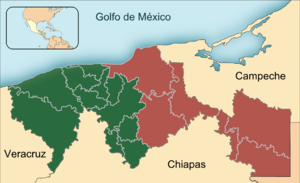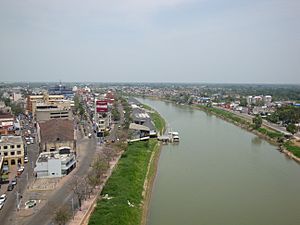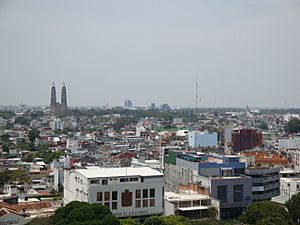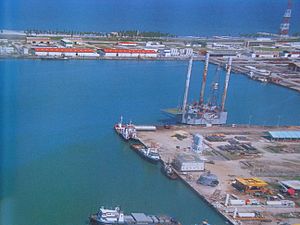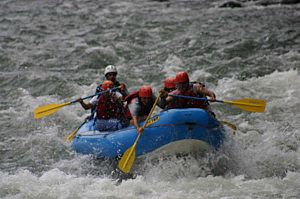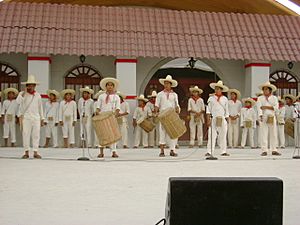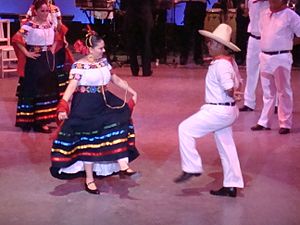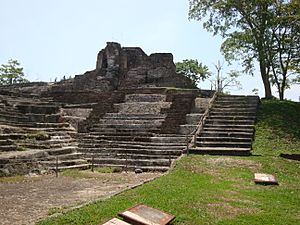Tabasco (state) facts for kids
Quick facts for kids
State of Tabasco
|
|||
|---|---|---|---|
|
|||
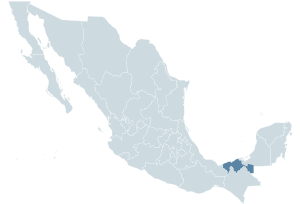
Location within Mexico
|
|||
| Country | |||
| Capital | Villahermosa | ||
| Municipalities | 17 in 4 zones | ||
| Area
Ranked 24th |
|||
| • Total | 25,267 km2 (9,756 sq mi) | ||
| Population
(2005)
|
|||
| • Total | 1,989,969 (Ranked 20th) | ||
| Time zone | UTC-6 (CST) | ||
| • Summer (DST) | UTC-5 (CDT) | ||
| HDI (2004) | 0.7684 - medium Ranked 21st |
||
| ISO 3166-2 | MX-TAB | ||
| Postal abbr. | Tab. | ||
| Website | Tabasco State Government | ||
Tabasco, officially the Free and Sovereign State of Tabasco, is one of the 32 Federal Entities of Mexico. It is divided into 17 municipalities and its capital city is Villahermosa. It is located in the southeast of the country, bordering the states of Campeche to the northeast, Veracruz to the west, and Chiapas to the south and the Petén department of Guatemala to the southeast. It has a coastline to the north with the Gulf of Mexico. Most of the state is covered in rainforest as, unlike most other areas of Mexico, it has plentiful rainfall year-round. For this reason, it is also covered in small lakes, wetlands and rivers. The state is subject to major flooding events, with the last occurring in 2007, which affected eighty percent of the state. The state is also home to La Venta, the major site of the Olmec civilization, considered to be the origin of later Mesoamerican cultures. Even though it produces significant quantities of petroleum and natural gas, poverty is still a concern.
Geography and environment
The state is located in the southeast of Mexico, bordering the states of Campeche, Chiapas, and Veracruz, with the Gulf of Mexico to the north and the country of Guatemala to the south and east. The state covers 24,731 square kilometres (9,549 sq mi), which is 1.3% of Mexico's total. The northwestern portion is on the coastal plain of the Gulf of Mexico with the south and east as part of the mountain chain that extends into northern Chiapas. It is divided into seventeen municipalities. There are 36 communities designated as urban, with about 3,000 smaller towns and villages. 185 are classified as "regional development centers". Tabasco has seventeen municipalities: Balancán, Cárdenas, Centla, Centro (Villahermosa), Comalcalco, Cunduacán, Emiliano Zapata, Huimanguillo, Jalapa, Jalpa de Méndez, Jonuta, Macuspana, Nacajuca, Paraíso, Tacotalpa, Teapa and Tenosique.
In 1994, the state was officially divided into two regions and five sub-regions for socioeconomic development and geographic documentation. The two major regions are called the Grijalva and the Usumacinta. The Grijalva Region is named after the river on which most of the municipalities here are dependent. It is the smaller of the two regions with a territory of 12,069.34 square kilometres (4,660.00 sq mi) or 48.94% of the state's territory; however, it contains most of Tabasco's urban population as well as of its socioeconomic and political activity. It is divided into three sub-regions called Chontalpa, Centro and Sierra; it includes the municipalities of Huimanguillo, Cárdenas, Comalcalco, Cunduacán, Paraíso, Jalpa de Méndez, Nacajuca, Centro, Jalapa, Teapa and Tacotalpa. The Usumacinta Region is named after the main river on which the Centla, Jonuta, Emiliano Zapata, Balancán and Tenosique municipalities depend. It is divided into the Pantanos and Ríos subregions, which are both more rural than the Grijalva Region.
The environment of the state consists of extensive low-lying floodplains, mountains and valleys. Most of the territory is covered with tropical rainforest and wetlands. There are also areas with savanna, beaches and mangrove forests. Much of the rainforest has suffered degradation due to over logging and conversion of territory into farmland. The east is formed by low humid plains formed by sediment deposited by a number of rivers. In the Chontalpa zone and in parts of the municipalities of Cental and Jonuta, there are swampy depressions extremely vulnerable to flooding from both riverflow and from excessive rainfall. In the south there are some elevations which are part of the central mesa of Chiapas. The most important of these is El Madrigal, La Campana, La Corona, Pomaná, Coconá, Mono Pelado and El Tortuguero. However, most hills in the state do not exceed 30 metres (98 ft) above sea level.
Tabasco has 198.8 kilometres (123.5 mi) of shoreline, 29,800 hectares (74,000 acres) of estuaries, lakes and numerous rivers and streams. Major rivers include the Mezcalapa, Pichucalco, Chacamax, Usumacinta, San Pedro y San Pablo and Tonalá. Almost all of the river system of the state belongs to the Usumacinta River-based, the largest in Mexico and the Grijalva River basin, the second largest. These basins encompass numerous rivers and streams which all eventually flow into the Gulf of Mexico. The only rivers outside these basins are the Tonalá, on the border between Tabasco and Veracruz and some small rivers in Chontalpa. On the coastline, there are numerous lagoons and some inland lakes. The most important of these are El Carmen, Pajonal, La Machona and Mecoacán. Because of the flat terrain, there are areas where rivers pool due to shallow depressions. The total volume of fresh water flow in the state is about 125,000,000,000 cubic metres (4.4×1012 cu ft), which is about 35% of the flow of the entire country. Flooding is a frequent occurrence, especially in September and November.
There are four principal ecosystems in the state: tropical rainforest, tropical savannah, beaches and wetlands. Tropical rainforest dominates most of the state due to the high levels of rainfall the area receives. However, what exists today is only a fraction of what used to be, as much of the forest area has been overexploited by man, mostly through logging and slash-and-burn agriculture. Most of the intact rainforest is found in the municipalities of Tenosique, Balancán, Macuspana, Teapa, Tacotalpa, Cárdenas and Huimanguillo.
These rainforests contain species such as mahogany, cedar, various types of palms, "macayo", ceiba, willows and many more. There are various types of orchids native to the state along with a native species of cactus. This environment also has the widest variety of wildlife, such as macaws, parrots, quetzals, hummingbirds, iguanas, and various kinds of snakes. Mammal species have declined because of deforestation, but still include spider monkeys, jaguars, pumas, raccoons, anteaters, deer, and wild boar.
Tropical savannah is mostly found in the southern part of the state, mixed in with areas of rainforest. These areas are dominated by grasses and bushes along with some smaller trees such as jahuacte, cocoyol and small palm trees. The savanna has wildlife such as rabbits, deer, foxes, and various species of birds.
Along the coast the soil is sandier and while the vegetation is still tropical, species are different than in the interior rainforest. They include coconut palms, palo mulato, royal palm and pimento de Tabasco. These areas have suffered the most from slash and burn agriculture.
Along these areas of forest are the beaches and wetlands of the state. The beach areas are dominated by ground vegetation which is able to tolerate the high salinity of the soil. The wetlands are dominated by the most extensive mangrove forests in Mexico, concentrated on the lagoons that border the Mezcalcpa River along with the banks of the Tonalá, San Pedro y San Pablo and Grijalva rivers. There are four main types of mangroves locally called red, white, black and "prieto". Most of the wetlands of the state belong to the Pantanos de Centla Biosphere Reserve. The abundance of fresh water in wetlands and river areas supports a wide variety of aquatic life such as freshwater gar, mojarra, crocodiles, various species of turtles and frogs, and many species of native and migratory waterfowl. In larger bodies of water manatees can be found. In the brackish and salt water lagoons various ocean species are found, as well as shellfish and mollusks, and bird species such as seagulls and pelicans.
Tabasco has a hot tropical climate, with the Gulf of Mexico having significant influence on weather patterns. Over 95% of the state's territory has a hot, wet climate. The rest is hot and semi-humid, located in the far northeast of the state. The average annual temperature is 27 °C (81 °F) with high temperatures averaging 36 °C (97 °F), mostly in May, and lows of 18.5 °C (65.3 °F) in January. Unlike many parts of Mexico, Tabasco has abundant year round precipitation. The state receives an average annual rainfall of 2,550 millimetres (8.37 ft). Rain occurs all year but is particularly heavy from June to October. The flat areas of the state are subject to frequent flooding. One reason for this is the rivers that flow from the Sierra region and the Usuamacinta River. Another is that there are a number of dams such as the Angostura, Chicoasén, Malpas and Peñitas; these are built for hydroelectricity and flood control, but can overflow.
The state has 17,138.2 hectares (42,349 acres) of state protected lands such as the Agua Blanca waterfalls and the Sierra State Park in Teapa. The Grutas de Coconá caves are classified as a natural monument with 422 hectares (1,040 acres). The Centla Biosphere Reserve covers an area of 302,706 hectares (748,000 acres). The Yumká Park and Laguna de las Ilusiones Ecological Reserves have 1,973.6 hectares (4,877 acres). The Laguna de la Lima Reserve has 36.2 hectares (89 acres). The Chontalpa Ecological Park has 277 hectares (680 acres). The Laguna del Camarón Ecological Park has 70 hectares (170 acres).
Economy
The state accounts for 3.4% of Mexico's national GDP. Although the recent oil boom has helped to bring the state out of complete poverty, there are still areas in which this is a serious problem. In the city areas coverage of running water, sewerage and electricity is over ninety percent; however, in the rural areas, running water is about forty percent, sewerage under seventy percent and electricity under 85%. The state has about 150,000 families or about half a million people living in poverty, mostly due to lack of employment according to Sedesol. Most of the state's poor are concentrated in the Jonuta, Tacotalpa, Centla and Humanguillo municipalities as these lack any major industry.
The heavy rainfall in the state does not lend itself well to annual crops and frequent flooding is a problem as well. Despite this, there is significant production of corn, sorghum and beans. Most of the commercially important crops are perennials, such as cacao, coconut, oranges, bananas and sugar cane. There is also important pasture, both natural and seeded. The state has extensive areas of natural grasslands. Due to the climate, the Zebu breed of cattle does best and is mostly raised for meat. Cattle accounts for about three quarters of the meat produced in the state. Other livestock includes pigs, sheep, goats and domestic fowl. Most livestock is raised in the Villahermosa, Cárdenas and Emiliano Zapata municipalities.
Tabasco has salt water and fresh water fishing along its shoreline and in the many rivers and small lakes but they are not extensively exploited, providing less than two percent of Mexico's total fish production. Commercial species include oysters, mojarra, shrimp, sea bass, shark, lobster and pejalagarto. Most fishing fleets are located in Frontera, with others in Sanchez Magallanes, Chilitepec and Dos Bocas. The state has natural resources such as mahogany, cedar and other tropical hardwoods.
Mining, mostly of petroleum and natural gas, provides most of the state's GDP. Only 14.6% of the working population is in mining. About 19% work in construction, transportation and manufacturing. Most manufacturing is food processing, bottling and tobacco products. About ninety percent of industrial establishments are family owned, mostly dedicated to food processing in and around Villahermosa. The most important industry is petroleum refining, done by PEMEX in the Macuspana municipality. There are 860 wells in various municipalities extracting crude oil and natural gas. It produces 556,371 barrels of crude oil and 1,363,000 cubic feet (38,600 m3) of natural gas per day. It has deposits of gravel and sand, along with the Cementos Apasco factory.
Just over 61% of the working population is employed in services and commerce. There are 86 traditional public markets. The Tabasco Fair is the most important commercial event. It has its origins in 1880. It has been held on and off since then in various locations. Today, it is held in Villahermosa at Parque Tabasco 2000 where the various municipalities of the state demonstrate their products. The current event also features cultural and sporting events as well.
Tourism
Tourism in the state is organized into various routes. The Centro or Villahermosa Route is centered on the state capital with its museums and historic buildings. These include the Cultural Center of Villahermosa, Regional Anthropology Museum, Tomás Garrido Canabal Park, the Yumka’ Ecological Reserve, The Paseo Tabasco Malecon Tourist Corridor, the Papagayo Interactive Museum and the Tabasco Cathedral.
The Cacao Route consists of various cacao haciendas, where guides give lessons on how the plant is cultivated and the cacao bean is harvested, then processed into chocolate. It also includes a visit to the Comalcalco archeological site. The Cacao Route focuses on the municipalities of Nacajuca, Jalpa de Méndez, Comalcalco and Paraíso. In Nacajuca, located on the river of the same name, the main attractions are its boardwalk area, handcrafts and surrounding Chontal villages such as Tucta, Mazateupa, Oxiacaque, Tecoluta and Guatacalca, where many customs and the Chontal language are preserved. In Jalpa de Méndez, the main attractions are its gourd handcrafts, the San Remo cigar factory, the La Encantada Turtle Farm and the Pomposú Juliva Wetlands on the Mezcalapa River. In Comalcalco, attractions include the Comalcalco archeological site, cacao haciendas such as La Luz with its Cacao Museum, Jesús María, La Chonita and Cholula. Paraíso is a small port with beaches and some resort facilities.
The River Route is based in the interior portion of the state, between the Grijalva and Usumacinta Rivers. This is an ecotourism route with activities such as canopy climbing, rafting and rappelling. There is also an option to visit the Ponomá archeological site. The River Route is on the interior portion of the state. It includes the Cascadas de Reforma Ecological Reserve, the Reforma Mayan archeological site, the Dr. José Gómez Pánaco Museum, the El Popalillo Lake and the Ribera de Acallán lookout point.
The Wetlands Route emphasizes flora and fauna both on land and on the water. The main attraction is the Centla Biosphere Reserve. The reserve is home to a wide variety of wildlife species such as herons, storks, ibis, crocodiles, fresh water turtles, manatees and more. There is also over 500 species of plants with some of the most important concentration of aquatic plants in Mesoamerica. Other attractions include the Centla maritime port, the Museum of Navigation, the town of Frontera (where the Spanish founded the first European settlement on mainland America) and the Punta Manglar Ecotourism facility. Beaches in the area include Pico de Oro, Playa Azul, Miramar and El Bosque.
The Mountain Adventure Route is in the highlands of the state with its forests, sulphurate waters and caves, centered on the town of Tapijulapa, which is noted for its handcrafts of wood and wicker. It features the hills, rainforest, sulfur springs and caves in the Teapa, Tacotalpa and Macuspana municipalities. Sites include he Río Puyacateno Park, Los Azufres Hacienda and Spa, the José Natividad Correa Tosca Museum and Coconá Caverns. Ecotourism activities include spelunking, rappelling and hiking.
The Olmec Zoque Route encompasses the municipalities of Cardenas and Huimanguillo. Cardenas is near the ocean with various attractions. One is the fishing village of Villa Sánchez Magallenes. Huimanguillo has archeological sites and a number of natural attractions. The best known is La Venta, an Olmec site but another important one is Malpasito, which belongs to the Zoque culture. In addition, there are areas of tropical rainforest, waterfalls, petroglyphs and lakes.
The Biji Yokot’an Route centers on the municipality of Nacajuca. It features the crafts of the area such as decorated containers made from gourds, its cuisine, especially river fish, the Chontal people of the area and the river boardwalk.
| Ecological and adventure tourism in Tabasco | ||||
 |
 |
 |
 |
 |
| Pantanos de Centla | Desarrollo Ecoturístico "Kolem-Jaa" | Cascadas de Aguas Blancas | Puerto Ceiba | Cañón del Usumacinta |
 |
 |
 |
 |
 |
| Grutas del Coconá | Sierra de Tabasco | Rápidos de San José-Desempeño | El Bellote | Tapijulapa |
Culture
Traditional masculine dress consists of a white shirt and pants, with black boots or shoes, black belt, a hat in a style called "chontal" and a red handkerchief around the neck. This dress is based on an older style of dress called "traje choco" which was made of cotton cloth called manta used to work in the fields. Traditional feminine dress consists of a wide skirt trimmed with a ruffle. Under the skirt is a slip designed to fluff the skirt and make the waist look smaller. The blouse is white with an embroidered band in bright colors, often with flower and/or animal designs. It has short sleeves ending in a square form in the lower part. The woman often carried a small handkerchief and a shawl called a rebozo in bright colors, often complementing the skirt. The shoes are black.
| Traditional dress of Tabasco | ||||
 |
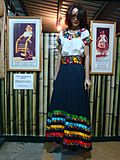 |
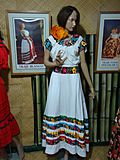 |
||
| Regional everyday dress | Regional semi-formal dress | Regional formal dress | ||
The state has a number of unique traditional dances due to its relative isolation from the rest of the country. These include "El Gigante" of Nacajuca performed on 14 August. "Baila Viejo" is performed in Tucta and Guaytalpa in the municipality of Nacajuca as well as the Atasta de Serra in Villahermosa. "El Pochó" is of pre Hispanic origin and performed during Carnival in Tenosique. "Los Blanquitos" is also performed in Tenosique and symbolizes the struggle of black slaves during the colonial period. "El Caballito Blanco" depicts the struggles of the indigenous against the Spanish at the Battle of Centla. "El Zapateo" is said to be derived from the fandango, brought to the area by a conquistador called Ortíz de Séquito. It is considered to be the regional dance of the state.
Traditional music has its origins in the Olmec period with other indigenous influences such as those of the Maya, Mexicas and Nahuas. It is based on flute and percussion, including drums made of tortoise shells and flutes/whistles made of ceramic. Purely indigenous music has almost entirely disappeared, replaced by that of European influence. Fandango influence was the first to arrive, which was modified then called fandanguillo leading to songs called zapateos in the colonial period, played by small orchestras. These were mostly composed of wind instruments but the marimba and drums called temborileros were added. This music was accompanied by a dance of the same name. Later, short improvised rhymes called "bombas" were added varying by region often consisting of a man and woman answering each other.
The cuisine is based on the foods of the ancient Mayas and Chontals, using plants and animals native to the region such as achiote, chili peppers, chipilin and banana leaves, with corn and beans serving as the base. (amashito) Traditionally, people in Tabasco eat seven times a day, these meals are called "puntal" (after getting out of bed), breakfast, "refigerio," "apertivo," "comida," "merienda" and "cena." This regime is based on rural work customs which required starting the day before the sun rose. Typical dishes include those with iguana meat, Lepisosteus fish, beef puchero, smoked oysters, totopostes, pork with beans and tortillas made with banana and fresh corn. Chocolate is still found in preparations which have not changed since pre Hispanic times mostly as hot and cold beverages. The most common cold chocolate beverage is pozol, served fresh or fermented. Each of the regions has certain specialties. Teapa is known for its cheese and longaniza sausage. Jalpa de Méndez produces head cheese, longaniza sausage and another cured meat called butifarra. Macuspana's dishes are often based on ingredients from the area's rivers such as bass, turtle and Lepisosteus. Paraíso is known for its oysters, often cooked in their shell over an open flame. Jalapa is known for its sweets such as sweetened fruits in corn husks, often accompanied by a cacao and corn beverage called chorote.
Tabasco is host to the boating marathon called the Mundo Maya on the Usumacinta and Grijalva rivers.
The state has sixteen important museums. Most are located in the Villahermosa area but others can be found in Comalcalco, Huimanguillo, Balancán, Emiliano Zapata, Jalpa de Méndez, Jonuta and Teapa. These include the Carlos Pellicer Museum (anthropology) Museum of Popular Culture, Museum of History and the La Venta site museum.
Patron saint days are still popular events in the state, with some of the more notable being San Isidro in Comalcalco and Nacajuca, James the Greater in Chontalpa, Our Lady of the Remedies in Nacajuca, Our Lady of the Assumption in Cupilco, Francis of Asissi in Tamulté de las Sabanas, events related with Lent in Atasta and Tamulté and the Saint Sebastian in Tenosique. There are also notable Carnival celebrations in Pochó, Tenosique and Villahermosa.
Archaeology
La Venta was the most important civic-religious center of the Olmec civilization, the first major culture of Mesoamerica. The site shows a number of the characteristics of Olmec culture, including depictions of jaguars, colossal heads and images of figures of rotund children. The site dates back to about 1000 BC and declined around 400 AD, replaced in importance by San Lorenzo. The museum associated with La Venta is in Villahermosa proper called Parque Museo de la Venta. It contain thirty three major pieces from the site and includes displays about Olmec customs, government, astronomy and writing. This park was created in the 1950s by writer Carlos Pellicer to protect the most important pieces of the archeological site. There are also exhibits on the flora and fauna of the area.
Comalcalco is a Maya archeological site near the modern city of the same name, on a bank of the Mezcalapa River. While it is not the only Mayan city whose monumental architecture is of adobe brick instead of stone, it is the only one which has had extensive reconstruction, open to the public. The Mayas here used adobe because of the lack of building stone in the area, instead using the abundant clay and lime extracted from shells. The Mayan city developed between 800 and 1100 AD, contemporary with Palenque and Yaxchilan. The name of the site comes from Nahuatl and means place of comals (a kind of cooking pan), but its Mayan name was Hoi Chan, which means cloudy sky. The site covers 577 hectares and with a total of 282 structures. The main monuments are La Plaza Norte, La Gran Acropolis and the Eastern Acropolis.
Malpasito is located near the modern settlement of the same name. This site is related to the Zoque culture and was at its height between 250 and 400 AD. To date, the site is only partially explored. The structures of the site rest on a series of artificial terraces with twenty seven mounds. These structures include a Mesoamerican ball court, a main plaza and a sunken patio. Another feature of the site is sixty petroglyphs.
Pomoná is a Mayan site discovered in 1959. The city was established in the Classic period achieving its height in the late Classic and falling in the early Post Classic. It is on the Usumacinta River, giving it an important role in the political and economic relations of the time as many ocean products passed through here on their way to the Peten area. Its original name is not known and it is currently named after a nearby modern settlement. It has six important groups of buildings with residential areas extending over 175 hectares.
Reforma is also known as Morales or Moral. There is little information about this Mayan sites but it had an established ruling lineage by 633 AD and was tied politically and economically with Pomoná, Palenque and Bonampak. The main plazas with their ceremonial structures are similar to those found in Tikal and the towers of Río Bec. There are seven principle structures surrounded by numerous smaller ones. Many of the stele from the site can be found at the José Gómez Panaco Museum in the nearby city of Balancán.
| Archaeological and colonial tourism in Tabasco | |||||||
 |
 |
 |
 |
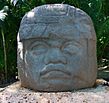 |
|||
| La Venta | Comalcalco | Pomoná | Moral-Reforma | Olmec Head, La Venta Park | |||
 |
 |
 |
 |
 |
|||
| Oxolotán | Cunduacán | Cupilco | Villahermosa | Tapijulapa | |||
Images for kids
-
The Entrance of Hernán Cortés into the City of Tabasco
See also
 In Spanish: Tabasco para niños
In Spanish: Tabasco para niños




